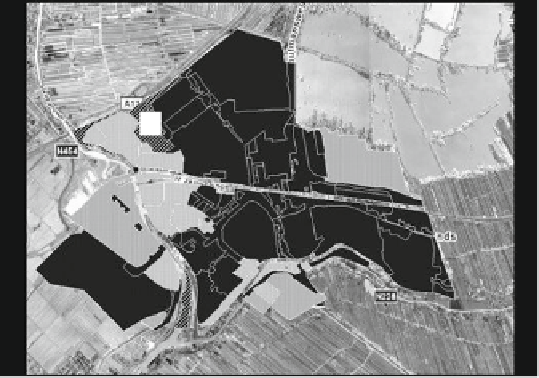Environmental Engineering Reference
In-Depth Information
Lakes
Lakes
D
D
A
A
B
B
Ind
Ind
D
D
Ind
Ind
Ind
Ind
C
C
B
B
Ind
Ind
D
D
D
D
Human Risk Assessment
Ecological Risk Assessment
Hazard Indices
Hazard Indices
Compounds Soil Use
A
B
C
D
Soil protection level
High
iddle
Low
As
0
.
1
0
.
0
2
0
.
0
2
0
.
0
0
0
.
4
0
.
3
0
0
.
1
5
Cd
0.68
0.06
0.00
0.00
1.20
0.43
0.12
Cr
0
.
0
0
.
0
1
0
.
0
1
0
.
0
0
0
.
3
0
.
2
5
0
.
0
9
Cu
0.07
0.01
0.00
0.00
1.24
0.38
0.24
Pb
5.31
1.39
1.02
0.21
9.02
1.28
0.37
Hg
0.06
0.00
0.00
0.00
4.62
0.30
0.11
Ni
0
.
0
0
.
0
1
0
.
0
1
0
.
0
1
0
.
3
0
2
9
0
.
1
2
Zn
0.26
0.02
0.00
0.00
7.49
5.21
0.85
Fig. 14.17
(
Top
) Soil use zones for an example municipality in the Netherlands. When a soil
zone is used as residential area, the soil quality for all contaminants in the soil should be safe for
that type of land use, and fall within the boundaries of the soil quality class “residential”. This is
easily checked per compound, but more difficult when there is a need to account for mixtures; in
such cases, the Risk Toolbox helps to implement the assessment steps. (
Bottom
) The Dutch Risk
Toolbox refines the Risk Assessments based on generic soil quality standards (Target Value and
Intervention Value). For this imaginary example, the toolbox specifies the local Hazard Indices
that result from local contaminants in relation to the different land uses. Left: human health-based
Risk Assessment. Right: ecologically-based Risk Assessment. Land use codes are: A
=
vegetable
garden, B
nature areas. Local risks of a contamina-
tion level for humans are present in residential areas, since the toxicity criterion of unacceptable
human risks was exceeded by a factor of 1.39 and 1.02 for residential areas with and without
garden, but highest for the soil use “vegetable garden” (due to which exposure through food con-
sumption is highest). The ecological Hazard Index at moderate protection for soil ecosystems (M,
a protection level chosen for residential areas) is highest for zinc, then for lead, then for copper.
The toxic pressure in this soil sample (msPAF) is 21%. H
=
residential, C
=
residential, no garden, D
=
=
high protection (soil use: nature, or
agriculture), M
=
moderate protection (residential), L
=
low protection (industry)
14.14.4.4 Management Assessment and Outcome Assessment
When the standard way of assessing risks appears insufficient, e.g. in the case of
large inventory lists of soils to be transferred or high levels of diffuse contamina-
tion or enhanced natural background concentrations, a municipality can choose to


































Search WWH ::

Custom Search